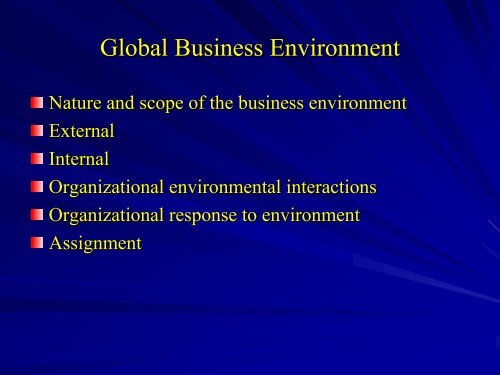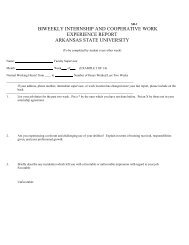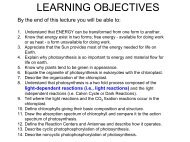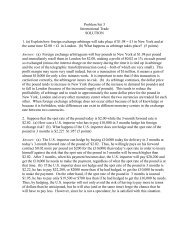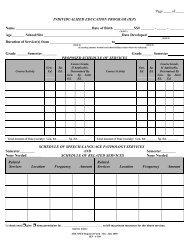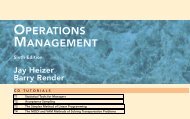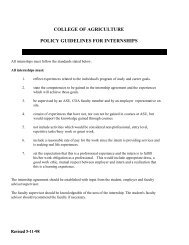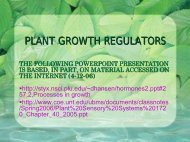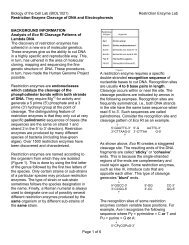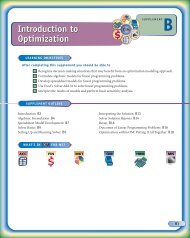Global Business Environment - Arkansas State University
Global Business Environment - Arkansas State University
Global Business Environment - Arkansas State University
Create successful ePaper yourself
Turn your PDF publications into a flip-book with our unique Google optimized e-Paper software.
<strong>Global</strong> <strong>Business</strong> <strong>Environment</strong><br />
Nature and scope of the business environment<br />
External<br />
Internal<br />
Organizational environmental interactions<br />
Organizational response to environment<br />
Assignment
<strong>Business</strong> <strong>Environment</strong> (1)<br />
Collectivity of all factors, forces & conditions<br />
outside & inside the organization that influences it as<br />
an organization & its behavior<br />
All the components of environment interact & affect<br />
one another & in turn business<br />
<strong>Environment</strong> is constantly changing faster for some<br />
industries & slower for others<br />
Adaptation needed by all
<strong>Business</strong> <strong>Environment</strong> (2)<br />
“<strong>Environment</strong> is also full of opportunities as well as<br />
poses some threats”-needs constant monitoring<br />
“Study of prevailing environment & its futuristic<br />
trends form an integral part of business planning”<br />
“<strong>Business</strong> operates always in an environment not in<br />
vacuum”
<strong>Business</strong> <strong>Environment</strong> (3)<br />
“<strong>Environment</strong> is a macro concept and business unit a<br />
micro”<br />
“Broadly environment is economic but its non<br />
economic face cannot be neglected i.e. socio-cultural<br />
cultural<br />
face”
Nature and Scope of <strong>Environment</strong><br />
External<br />
Macro<br />
environment<br />
Demographic<br />
Political<br />
Economic<br />
Legal<br />
Social<br />
Technological<br />
International<br />
Specific task<br />
<strong>Environment</strong><br />
Clients<br />
Customers<br />
Owners<br />
Share holders<br />
Competitors<br />
Suppliers<br />
Regulators<br />
Market forces<br />
Internal<br />
Micro<br />
Board of<br />
directors<br />
Employees<br />
Culture<br />
Values<br />
Work ethos<br />
Processes &<br />
systems
Organization and its environment<br />
Technological<br />
Competitors<br />
Social-culture<br />
Economics<br />
Suppliers<br />
Internal <strong>Environment</strong><br />
Board of Directors<br />
Employees<br />
Processes<br />
Culture<br />
Climate<br />
Clients<br />
International<br />
Regulators<br />
Labor<br />
Task <strong>Environment</strong><br />
Political-Legal<br />
<strong>Business</strong> <strong>Environment</strong>
TECHNOLOGICAL<br />
Follow developments in silicon chips.<br />
Spend 6.9% of revenues on research.<br />
ECONOMIC<br />
Law interest<br />
rates. Low<br />
Unemployment<br />
Low inflation.<br />
Strong dollar.<br />
Recession<br />
In Midwest and<br />
Southwest<br />
COMPETITORS<br />
Compaq, DEC, TI, AT&T<br />
New entrants.<br />
Shift: Isolated Products to<br />
Integrated IS,<br />
Rapid expansion<br />
IBM<br />
SUPPLIERS<br />
Subcontractors provide<br />
components for machines.<br />
Microprocessors<br />
from Taiwan.<br />
Printer from Japan<br />
Share / Bondholders<br />
CUSTOMERS<br />
Declining growth rate<br />
<strong>Business</strong>es, Universities<br />
Schools, Want lower prices<br />
Target computer layperson<br />
Loyal like IBM service<br />
HUMAN RESOURCE<br />
Treat employees well<br />
No layoff policy potential<br />
Unions College<br />
graduates<br />
S0CIO-<br />
CULTURAL<br />
Computer use in<br />
schools at all<br />
levels.<br />
Inexperienced<br />
computer<br />
laypeople<br />
Computer piracy<br />
and fraud New<br />
computer<br />
applications.<br />
Home and family<br />
use, computer<br />
games<br />
LEGAL/POLITICAL<br />
Steps to regulate software information<br />
Privacy laws. Potential antitrust suit<br />
Protectionist legislation in other<br />
countries New tax laws<br />
INTERNATIONAL<br />
Sell products in 130 countries Hire<br />
nationals in host countries. Buy machine<br />
parts from foreign suppliers 40% of<br />
revenues from foreign sales
Demographic <strong>Environment</strong> of a Country<br />
Population<br />
Growth rate<br />
Life style of people<br />
Trend towards<br />
urbanization<br />
Literacy levels<br />
Unemployment levels<br />
Labor market<br />
Technical manpower<br />
Managerial manpower<br />
Occupation<br />
– Sex composition<br />
– Age-wise composition<br />
Unionization<br />
Contingency analysis
Political <strong>Environment</strong><br />
Type of political system<br />
– Federal / Local<br />
Special interest groups<br />
– Consumers<br />
– Farmers<br />
– <strong>Business</strong> associations<br />
Social reformers<br />
Cultural sects<br />
Political climate<br />
– anti business / pro business<br />
Regulatory control<br />
Trade unions act<br />
Laws for consumer<br />
protection<br />
Laws of managerial<br />
remuneration<br />
Taxation<br />
Other standards<br />
Judiciary system<br />
Administrative system<br />
Stable climate for doing business
Technological <strong>Environment</strong><br />
Technology, business development and growth of<br />
economy closely inter related<br />
New medicines, biotech field, cosmetics, auto<br />
telecom, computers, fiber optics, xerography<br />
Effect of new technology on old business<br />
Technological gaps
Critical Elements of Economic <strong>Environment</strong> 1<br />
Economic system – public, private, capitalistic,<br />
communist or mixed<br />
Nature of economy – country’s s economic health<br />
Functioning of economy – role of money is to give<br />
insight into role of planning, administered prices, free<br />
market pricing and central banking
Critical Elements of Economic <strong>Environment</strong> 2<br />
Economic controls and regulations – industrial policy,<br />
agricultural policy, fiscal cum budgetary policies, regulations<br />
of central bank, import-export policy, industrial development<br />
& regulations act, price control, trade control & exchange<br />
control act<br />
Economic problems & prospects – inflation, unemployment<br />
and recession
Economic <strong>Environment</strong><br />
Economic health<br />
– GNP<br />
– personal income<br />
– disposable personal income<br />
– personal consumption<br />
patterns & expenditures<br />
– retail sales<br />
Savings<br />
– Personal<br />
– <strong>Business</strong><br />
Investment<br />
– New equipment<br />
– Inventory<br />
Price, wages &<br />
productivity<br />
Inflation rate , consumer<br />
price index<br />
Output / hour / business<br />
sector<br />
<strong>State</strong> & local expenditure<br />
Defense expenditure<br />
<strong>Business</strong> / Investment Climate<br />
(assign grade = A+, A, B, C)
Organizational <strong>Environment</strong> Interactions<br />
Two linkages to be examined<br />
<strong>Environment</strong>al change, complexity & uncertainty<br />
Competitive forces<br />
– Degree of change in the environment- stable or unstable<br />
– Degree of environment’s s homogeneity<br />
– <strong>Environment</strong>-simple or complex<br />
SIMPLE<br />
COMPLEX<br />
few elements & little segmentation<br />
more elements, high degree of segmentation
Complex<br />
Simple<br />
H<br />
O<br />
M<br />
O<br />
G<br />
E<br />
N<br />
E<br />
I<br />
T<br />
Y<br />
Moderate<br />
uncertainty<br />
Least<br />
uncertainty<br />
Most<br />
uncertainty<br />
DEGREE OF CHANGE<br />
Moderate<br />
uncertainty<br />
Stable<br />
Dynamic
Factors Affecting Uncertainty & Dependence<br />
<strong>Environment</strong> is more uncertain & less easy to<br />
understand when<br />
– it is more differentiated<br />
– it is changing<br />
– numerous interconnections among its various elements<br />
Organizations more dependent in an environment where<br />
– Required resources are not widely available<br />
– Resources are not evenly distributed<br />
– Increasing connectedness disturbs elements of environment &<br />
the linkages among them
External (Competitive) Forces<br />
Threat of new entrants<br />
Jockeying among contestants<br />
Threat of substitute products<br />
Market Power (buyers)<br />
The<br />
Organization<br />
Market Power (suppliers)
Organization’s s Response to <strong>Environment</strong><br />
Boundary spanning response<br />
Forecasting<br />
Strategic responses<br />
Mergers, acquisitions and joint ventures<br />
Change of structures<br />
System integration
Boundary Spanning Response 1<br />
(a)<br />
(b)<br />
Organization reaction based on mgt of info<br />
A popular mgt info technique is called boundary<br />
spanning response<br />
Roles performed by PRO’s, , sales representatives &<br />
procurement agents/officers<br />
Close contact required to be maintained by all, outside<br />
serves 2 purposes<br />
Seek & process info about changes in environment<br />
Represent organization interest outside
Boundary Spanning Response 2<br />
Boundary spanners assist in environment scanning<br />
Boundary spanners assist & process of monitoring<br />
Understand interacting forces between organization &<br />
its complex & dynamic environment
Systems Criteria for Evaluating<br />
Company Performance (1)<br />
Ordinate system<br />
Shareholders<br />
Labor force<br />
Consumers<br />
Evaluation criteria<br />
Price appreciation of<br />
securities<br />
Dividend payout<br />
Wage levels<br />
Opportunity<br />
Employment stability<br />
Value given
Systems Criteria for Evaluating<br />
Company Performance (2)<br />
Competitors<br />
Suppliers<br />
Creditors<br />
Community<br />
Nation<br />
Rate of growth<br />
Innovation<br />
Rapidity of payment<br />
Adherence to contract terms<br />
Contribution to community<br />
development<br />
Public responsibility
Summary<br />
<strong>Business</strong> environment means surroundings, conditions,<br />
situations & trends<br />
General environment is created by political, economic,<br />
social & technological factors<br />
<strong>Business</strong> has internal as well as external environment<br />
<strong>Business</strong> environment is complex<br />
phenomenon,organizations should adapt to it<br />
<strong>Business</strong> environment is the foundation of corporate<br />
planning<br />
<strong>Environment</strong>-objectives<br />
objectives-strategies-structure-systemsystem
The Firm as a System<br />
competitors<br />
community<br />
suppliers<br />
finance<br />
The Firm<br />
Production<br />
Marketing<br />
creditors<br />
labor<br />
Facilitating services<br />
nation<br />
consumers<br />
shareholders
Assignment<br />
In what ways are the major dimensions in the<br />
external environment changing in today’s world<br />
Illustrate. How can you face these challenges<br />
Create an organizational-environmental chart for<br />
your favorite company.<br />
Prepare a “country report” for any country of your<br />
choice including the different “environments”.<br />
☺


